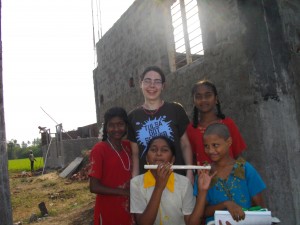WIT Life #103: The Cove
*********************************************************
WITLife is a periodic series written by professional Writer/Interpreter/Translator Stacy Smith (Kumamoto-ken CIR, 2000-03). She starts her day by watching Fujisankei’s newscast in Japanese, and here she shares some of the interesting tidbits and trends together with her own observations.![]()
An article in today’s Times discusses the reaction of right wingers in Japan to The Cove, a documentary about dolphin hunting in a place called Taiji. This group, 右翼 or uyoku, are said to number about 10,000 throughout the country and have been responsible for various acts of violence such as torching the houses of politicians whose views they don’t agree with (i.e. regarding visits to Yasukuni Shrine). This time they are protesting outside theaters attempting to show this film, insisting that it will “poison Japan’s soul.” However, there is significant interest in this doc as evidenced by the turnout of over 700 people for a one-time screening in Tokyo last week, where about 100 had to be turned away due to lack of space.
Quoted in the article is the documentary filmmaker and author Tatsuya Mori, who I Read More
WIT Life #101: Empire State Turns Japanese!
WITLife is a periodic series written by professional Writer/Interpreter/Translator Stacy Smith (Kumamoto-ken CIR, 2000-03). She starts her day by watching Fujisankei’s newscast in Japanese, and here she shares some of the interesting tidbits and trends together with her own observations.
In a previous post about the recent Japan Day in Central Park, I mentioned the introduction of a samurai procession.  This was one aspect of celebrating this year’s 150’s anniversary of the first Japanese diplomatic mission to the United States and its enthusiastic reception in New York City on June 16, 1860. According to a press release from the Japanese Consulate of New York, “the visit by a group of over 70 samurai was one of the greatest spectacles the city had ever seen: an estimated half-a-million New Yorkers jammed the streets to watch the Japanese parade up Broadway and two weeks of grand balls, celebrations, and non-stop press reports welcomed the visitors from across the sea.” The samurai brought with them instruments of ratification for the 日米修好通商条約 (Nichibei shuukou tsuushou jouyaku) or U.S.-Japan Treaty of Amity and Commerce.
This was one aspect of celebrating this year’s 150’s anniversary of the first Japanese diplomatic mission to the United States and its enthusiastic reception in New York City on June 16, 1860. According to a press release from the Japanese Consulate of New York, “the visit by a group of over 70 samurai was one of the greatest spectacles the city had ever seen: an estimated half-a-million New Yorkers jammed the streets to watch the Japanese parade up Broadway and two weeks of grand balls, celebrations, and non-stop press reports welcomed the visitors from across the sea.” The samurai brought with them instruments of ratification for the 日米修好通商条約 (Nichibei shuukou tsuushou jouyaku) or U.S.-Japan Treaty of Amity and Commerce.
Another exciting promotional event commemorating this historical occasion is Read More
WIT Life #100: ダーリンは外国人
**************************************************************
WITLife is a periodic series written by professional Writer/Interpreter/Translator Stacy Smith (Kumamoto-ken CIR, 2000-03). She starts her day by watching Fujisankei’s newscast in Japanese, and here she shares some of the interesting tidbits and trends together with her own observations.
Last night I went to see the US premiere of ダーリンは外国人 or My Darling is a Foreigner. This film is based on the manga series with the same title by Saori Oguri. I was introduced to this work by a Japanese friend shortly after it came out in 2002, and I devoured the volumes that were available at the time. It depicted the day to day life of this international couple and the bumps that they encountered along the road of their relationship. They eventually went on to have a child together, and since the first book went on sale this popular series has sold 3 million copies.
Tony is the name of Saori’s husband and he hails from the United States. He is Read More
WIT Life #99: Japan Day
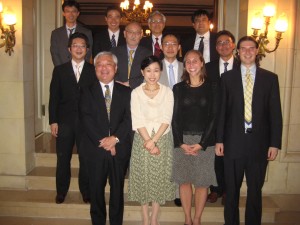
Reception at the residence of Ambassador Shinichi Nishimiya (front left), accompanied by his lovely wife Yukiko and the author on her right
WITLife is a periodic series written by professional Writer/Interpreter/Translator Stacy Smith (Kumamoto-ken CIR, 2000-03). She starts her day by watching Fujisankei’s newscast in Japanese, and here she shares some of the interesting tidbits and trends together with her own observations.
The heavens held out for this year’s Japan Day, despite the forecast of impending showers. I was at the residence of Ambassador Shinichi Nishimiya on the Friday night before the event, and he assured all the guests that it would not be raining come Sunday. Sure enough, there was a huge amount of humidity but the skies were clear. The Ambassador himself made multiple appearances through the day, initially at the four mile run in Central Park that kicked off the event. I was one of the participants, and was happy to see him dressed as a samurai greeting runners as we began the race. Later in the day he was still in costume and made his way through the throngs of people attending the festivities in the East Meadow.
A new aspect of this year’s event, its fourth holding, was a samurai parade. This procession, led by the band from the NYPD, included Read More
WIT Life #98: 鳩山おろし
***********************************************************************************
WITLife is a periodic series written by professional Writer/Interpreter/Translator Stacy Smith (Kumamoto-ken CIR, 2000-03). She starts her day by watching Fujisankei’s newscast in Japanese, and here she shares some of the interesting tidbits and trends together with her own observations.
This morning’s news was buzzing with the announcement that Prime Minister Yukio Hatoyama will be stepping down from his position. This makes him the fourth PM in four years to quit, a statistic that will likely lead to some self-reflection in Japan. The 2 main reasons cited for his resignation were 1) 普天間問題 (Futenma mondai or the fate of the Futenma Marine Corps Air base on Okinawa) and 2) 政府と金 (seifu to kane or government and money, the investigations being carried out regarding Hatoyama’s political financing).
As for the former, Hatoyama directly apologized to Okinawans for his waffling on the matter and the loss of faith he had caused as a result. When on the street interviews were conducted with Okinawa residents, the response was largely one of disappointment and regret that Hatoyama was cutting and running. In terms of the latter, Hatoyama pledged to “return to a DPJ that separates government and money and to deal with the issue properly.”
The title of this post is 鳩山おろし (Hatoyama oroshi or “Down with Hatoyama”), referring to Read More
WIT Life #97: Anko obsessed
WITLife is a periodic series written by professional Writer/Interpreter/Translator Stacy Smith (Kumamoto-ken CIR, 2000-03). She starts her day by watching Fujisankei’s newscast in Japanese, and here she shares some of the interesting tidbits and trends together with her own observations.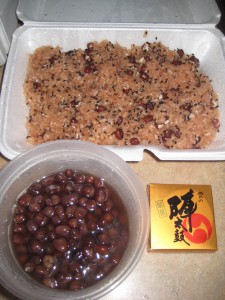
For those of you who have been faithful readers of my blog, you probably have a sense of the sweet tooth that I have, especially regarding 和菓子(wagashi). This is something known well by those closest to me, as well as those looking for the fastest way into my heart :) My birthday was this past weekend, and my friends came through with flying colors in terms of satisfying my cravings for something sweet.
I celebrated my birthday with dinner at Koiso, the best Japanese restaurant in NY (and I’m not saying that just because I used to waitress there!). It is a truly authentic family-run joint where regulars dominate the clientele, and there are always multiple conversations taking place in Japanese. Taisho (the sushi chef), gets his supplies from the Freeport Fish Market, and he always lets customers know what fish are the freshest that day. Omakase (leaving it in the hands of the master) is definitely the way to go for the best sushi/sashimi!
Taisho’s wife Kyoko-san is the waitress and all-around life of Koiso, and the warmest woman you will ever want to meet. For my birthday, she had all of my favorites prepared. As you can see in the picture on the right resembling an anko trifecta, she made me a generous portion of Read More
WIT Life #96: ヒューストンの日本庭園
WITLife is a periodic series written by professional Writer/Interpreter/Translator Stacy Smith (Kumamoto-ken CIR, 2000-03). She starts her day by watching Fujisankei’s newscast in Japanese, and here she shares some of the interesting tidbits and trends together with her own observations.
The hot, humid weather down here in Houston certainly takes its toll on the body, but I was able to enjoy a morning run this weekend with one of the participants in my group (By the way, this fellow runner is also a former interpreter, and I would highly recommend her Japanese-only very entertaining blog). Our destination was Hermann Park located just off of the Rice University campus, and when we arrived and did some exploring we were able to find a Japanese garden! (日本庭園 or Nihon teien)
It was authentic in all respects, with manicured paths and a large tea house in the back. We took respite in the shade and Read More
WIT Life #95: 事業仕分け
WITLife is a periodic series written by professional Writer/Interpreter/Translator Stacy Smith (Kumamoto-ken CIR, 2000-03). She starts her day by watching Fujisankei’s newscast in Japanese, and here she shares some of the interesting tidbits and trends together with her own observations.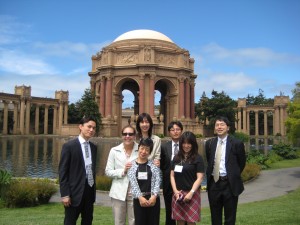
The Japanese government is currently undertaking 事業仕分け (jigyo shiwake), budget screening or review and prioritization of government projects. This has become a buzzword since the DPJ came into office promising to eliminate wasteful government spending. The party sees this reassessment method as a potentially powerful way to chop budgets. It is being carried out to the point where no one knows where the ax will fall next.
In fact, the group I am currently interpreting for is here in the U.S. for a year through a program carried out by Japan’s National Personnel Authority and supported by the State Department. They are representatives of a variety of Ministries and will spend their time researching and producing papers on topics relating to their respective fields, with the hopes of applying this knowledge when they return home. However, they are concerned that due to jigyo shiwake there might not be a group to succeed them next year.
I recently received news from a friend at the Japan Local Government Center, the New York branch of the Council for Local Authority on International Relations (CLAIR), one of the sponsors of the JET program. He told me that Read More
WIT Life #94: Beard Papa and other familiar favorites
WITLife is a periodic series written by professional Writer/Interpreter/Translator Stacy Smith (Kumamoto-ken CIR, 2000-03). She starts her day by watching Fujisankei’s newscast in Japanese, and here she shares some of the interesting tidbits and trends together with her own observations.
Today is our last full day in San Francisco, so I decided to explore some of the offerings in the immediate vicinity of where I am staying, Hotel Nikko. Here in the lobby there are so many Japanese customers that I occasionally get flashbacks to the many times I spent in Kumamoto’s Hotel Nikko at various events during my time on JET. Natsukashii!
I went for a walk to the local mall with my co-interpreter who was on a mission to find cream puffs. I had no idea that Beard Papa had an outpost here on the West Coast, but sure enough Read More
WITLife is a periodic series written by professional Writer/Interpreter/Translator Stacy Smith (Kumamoto-ken CIR, 2000-03). She starts her day by watching Fujisankei’s newscast in Japanese, and here she shares some of the interesting tidbits and trends together with her own observations.
My interpreting travels bring me to San Francisco this time, and I couldn’t leave without paying a visit to Japantown. I hadn’t been there in a couple of years, but I clearly remembered the array of restaurants, souvenir shops and an onsen-like spa I once had a soak in. I went with a friend who was craving something sweet and wanted a recommendation, so I suggested we get 白玉汁粉 (shiratama shiruko), one of my favorite Japanese desserts following ぜんざい (zenzai). We ended up at Kissako Tea where we were served by Hiro and Koji, pretending to be a charming 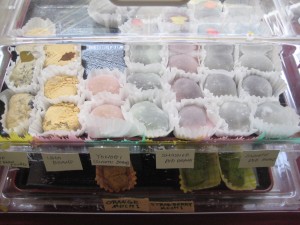 couple in the picture on the right.
couple in the picture on the right.
Kissako also had a nice selection of mochi (pictured left), including Read More
WITLife is a periodic series written by professional Writer/Interpreter/Translator Stacy Smith (Kumamoto-ken CIR, 2000-03). She starts her day by watching Fujisankei’s newscast in Japanese, and here she shares some of the interesting tidbits and trends together with her own observations.
Last week there was an interesting article in the NYT about Chinese teachers who are sponsored by their  government (with additional support from local school districts) to come teach here in the States for up to three year. It reminded me of JET, as well as my own experience first learning Japanese in high school. The article featured a young woman teaching in rural Oklahoma, and the cultural roadblocks she encountered along the course of her job (American students lack of geographical knowledge, pregnant teenagers, etc.). I love the quote she provides at the end of the article regarding what she hopes to impart to her students: “I want my students to have a sweet, sweet memory of taking Chinese. They won’t remember a lot of words, but I want them to remember the beauty of the language and the culture.”
government (with additional support from local school districts) to come teach here in the States for up to three year. It reminded me of JET, as well as my own experience first learning Japanese in high school. The article featured a young woman teaching in rural Oklahoma, and the cultural roadblocks she encountered along the course of her job (American students lack of geographical knowledge, pregnant teenagers, etc.). I love the quote she provides at the end of the article regarding what she hopes to impart to her students: “I want my students to have a sweet, sweet memory of taking Chinese. They won’t remember a lot of words, but I want them to remember the beauty of the language and the culture.”
It calls to mind the power of teachers and how a good one can have a dramatic effect on your future. As for me personally, I can definitely say that I would not be where I am today without the existence of my amazing high school Japanese teacher, Sensei Watson. It was her unique teaching style and incorporation of non-traditional methods, like showing us 紅白歌合戦 (kouhaku uta gassen or New Year’s Eve Singing Content) and having us write 年賀状 (nengajou or New Year’s greeting cards) before Oshougatsu that initially made me curious about this country that seemed to be so different from my own. I am eternally grateful to her for getting me started on my lifelong journey of discovering Japan!
WIT Life #91: More than just mochi
WITLife is a periodic series written by professional Writer/Interpreter/Translator Stacy Smith (Kumamoto-ken CIR, 2000-03). She starts her day by watching Fujisankei’s newscast in Japanese, and here she shares some of the interesting tidbits and trends together with her own observations.
I have already written about my obsession with Kansai Yamato, an amazing mochi maker located in Honolulu’s Ala Moana mall. I am lucky enough to be back in Hawaii with my current group (someone up there likes me!), so of course I had to pay a visit as soon as I got into town. As the shelves were fully stocked, I was able to find some items I had not seen before. In addition to the wide variety of mochi, they had some other goodies like the kabocha bread in the picture on the right. As a huge pumpkin fan, I had to try it. I was expecting something along the lines of Japan’s mushi pan (steamed bread), but it was more substantial, similar to the consistency of a moist muffin (shittori shite iru). These two large piec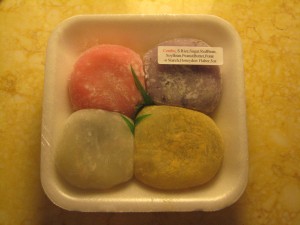 es cost $2.99 plus tax, well worth the price.
es cost $2.99 plus tax, well worth the price.
Aside from getting some of the unusual flavors that I come to Kansai Yamato for (peanut butter & chocolate, Oreo, etc.), I got a mochi sampler ($3.99 plus tax) that included a variety of types. Shown on the left, it is comprised of (from top left clockwise) peanut butter, Okinawan sweet potato, kinako with red bean paste and what is labeled as honeydew (though it’s not very green in color). Clearly my sweet tooth will be satisfied for the next few days…
WIT Life #90: 感謝の気持ち
WITLife is a periodic series written by professional Writer/Interpreter/Translator Stacy Smith (Kumamoto-ken CIR, 2000-03). She starts her day by watching Fujisankei’s newscast in Japanese, and here she shares some of the interesting tidbits and trends together with her own observations.
Following our time in America’s heartland my group and I have since moved to the Bay Area, where we are continuing our study of food safety here in the States. One participant requested that we go to eat at a vegan restaurant, as this is not a common concept in Japan. In fact, one night we had a heated conversation regarding the distinction made between the values of plant/animal lives, as well as the viab ility of vegetarianism. Veganism was a whole other extreme for them, but as they say, don’t knock it till you’ve tried it. So we were off to San Francisco’s Cafe Gratitude.
ility of vegetarianism. Veganism was a whole other extreme for them, but as they say, don’t knock it till you’ve tried it. So we were off to San Francisco’s Cafe Gratitude.
My participants were surprised at how delicious all the food was despite the limited ingredients. We had a sampler which included Read More
WIT Life #89: 空気人形
WITLife is a periodic series written by professional Writer/Interpreter/Translator Stacy Smith (Kumamoto-ken CIR, 2000-03). She starts her day by watching Fujisankei’s newscast in Japanese, and here she shares some of the interesting tidbits and trends together with her own observations.
My current DOS interpreting assignment regarding food safety has kept me busy, but a weekend here in the farm country of Illinois has allowed some time to catch up. When I was in DC earlier this week, the annual Filmfest featuring a variety of international films was taking place. While flipping through the program booklet, I was happy to find that the latest release of one of my favorite Japanese directors, Hirokazu Kore-eda, was being screened. Some of his well-known previous works are After Life (ワンダフルライフ), Nobody Knows (誰も知らない) and Still Walking (歩いても 歩いても), and his newest is Air Doll (空気人形).
This two-hour plus movie came out in Japan last year, and it is based on Read More
Another Side of Travel
*************
Laura is a current JET who writes fantasy and science fiction for children and young adults, and is an occasional playwright/film maker.
Namaskaram! Greetings from India! Ever consider volunteering abroad? With all our JET paid vacation time, there`s lots of opportunities. It looks great on your resume, and it’s a sure way to give you inspiration for your writing! Why stick to the touristy spots you can read about? You can get a feel for “the real thing” by helping out in the rural villages and slums, and see a part of the world you might never see otherwise.
I definitely just got a feel for the “real India” after spending ten days in Andhra Pradesh building houses and teaching the children of Dalits (untouchables) with five other English teachers through Longitude International. What an amazing experience! The moment we entered Chuvuru village we were greeted by drums and dancing. The people welcomed us into their homes and there seemed no end to the smiles, laughter, and chai tea!
We spent our mornings helping build new cement houses that would stand the tempest of the fall monsoons, and our evenings teaching and playing with the children. In the beginning they were shy and called me “madam,” but within a few hours they completely opened up and called me “sister.” “Sister, one more song, one more photo, one more dance!” Boy, did they love to dance! We taught them the hokey pokey, the Macarena, head-shoulders-knees-and-toes, everything we could think of, and in return they showed us their “Bollywood moves.” They also loved my fife and recorder. Whenever I brought them out, they instantly began shouting requests.
During a game of “let`s travel,” one of the kids asked me, “Your village?” I didn`t know how to respond. Temple, Texas, where I was born? Owasso or Tulsa Oklahoma where I was raised and went to school? Nabari, Japan, where I live now? Malawi, Africa, where I left a huge part of my heart with the AIDS orphans? Or right there in Chuvuru where I felt so at home?
It was a bit of an identity crisis. I asked myself if I really “belong” anywhere. For weeks I`ve been nervous about my upcoming visit back to the States and wondering if it has “changed,” or more importantly, if I`ve changed. Will I feel “at home” in the place my friends and family consider to be my “home?”
After puzzling over it I came to a rather relieving, though somewhat clichéd conclusion. The world is my village. Perhaps that sounds cheesy, but I really think so. Not that I would be welcome let alone feel comfortable anywhere in the world, but I think wherever I do go where there are welcoming hearts and warm smiles, that place will be my home, my village for as long as I am there. And the villagers of India really are so welcoming, so loving that you feel like one of them from the very beginning. There is no insider/outsider. Only friend and family.
Of course, the trip wasn`t all fuzzy feelings. It was very difficult to see how some of the people suffered. Thirty years ago in a nearby village, the government gave the Dalits land to farm, but are now taking it back. This forces the villagers to migrate long distances through dangerous roads or hire themselves out as domestic servants where they are physically and sexually abused. Disease is still a major problem, claiming many lives.
So a lot of people have asked me, why did you bother going to India? There`s not much you can do to help anyway; why not just send money? Sending money is great, but if I`m traveling anyway, I might as well make a difference as I do and experience the “real world.” I can already tell you, those kids and that place are already showing up in my fiction!
We were the first volunteer group to visit Chuvuru, but this is only the beginning of their brighter future. Hopefully many more teams will come to help build and teach, continuing the cause of awareness, human rights, and global friendship. Who knows, maybe you`re next? If you`re interested in learning more about longitude and their work, you can visit their website at http://www.golongitude.org/.
For more details, pictures, and videos about Laura`s adventures in Asia, visit her weekly blog at laurajanepopp.blogspot.com.

